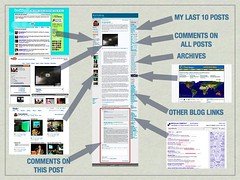Sorry to be picking on Kim Cofino so much lately, but she’s blogging like a woman possessed! 🙂 Kim just twittered about a post written by Struan Robertson, one of her school admin team at the school where she works in Thailand. It’s a great post Struan (who incidentally, started blogging after the Shanghai Conference on the weekend – good for you!)
Given all the talk over the last few days about connectedness and how our networks of like-thought are linking us all together globally, this paragraph really jumped out at me. For those that may not know, Kim is an American teacher who was working in Malaysia until last year and now works at an International school in Thailand. And how does a school in Thailand find talent like Kim?…
“I was also amazed at the impact of blogging. We met and hired Kim Cofino last year through blogging because we already knew how/what she thought. Are we “inventing” a new way to run our HR Dept.? We hire people because of how they think, independently of what “smart” things they write on their CVs? How could that impact international school job/recruiting fairs? Kim came up to me on Saturday at the conference and excitedly told me how Will Richardson (Weblogg-ed) wanted to meet her. Why? Because he follows her blog (Always Learning) and wanted to put a face to the mind, not a “name to the face”. How different is that? Justin and Dennis saw Jeff Utecht (The Thinking Stick) from Shanghai Amercian School and greeted him like an old friend. When I asked Justin how long they had been friends, he replied that this was the 2nd time they had met. In other words, because they read each other’s blog and know how the other thinks, they are great virtual and real-life friends. Whoa!!!”
It’s pretty amazing when you think about it. I remarked to someone today that if I was after advice on a particular educational question or issue, I would be far more likely to reach out to my network of connections – people I’ve mostly never met face to face – for an answer than I would even to my local colleagues at school. I mean, I work with nice people and I like them a lot, but none of them are as connected, as switched on, as forward thinking as the people at the other end of my networks…
I was surprised a few weeks ago when I had a phone call from a leader of a school here in Sydney who asked me if I would be willing to run some technology integration sessions for his staff. He wanted me to just come along for the day and “expand their minds” with regard to new media, Web2.0 and how technology was impacting 21st century education. Naturally, I said yes, and was really excited about it… but what floored me was when I asked him how he happened to come into contact with me… where did he get my name from? “Your blog”, he replied. Wow.
I’ve actually quit the teaching profession twice now, leaving to do other things outside of education, because there have been times when I’ve really doubted my ability as a teacher. But I keep coming back to it, certainly not because of the money, but because there is no other calling that makes as much of a difference as teaching and no other time in history where I feel it’s more important to be a part of it.
Tags: kimcofino, jeff utecht, struan robertson, connectedness, learning2.0

